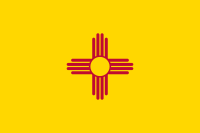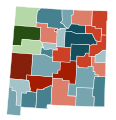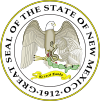Portal:New Mexico
The New Mexico Portal New Mexico (Spanish: Nuevo México [ˈnweβo ˈmexiko] ⓘ; Navajo: Yootó Hahoodzo Navajo pronunciation: [jòːtʰó hɑ̀hòːtsò]) is a landlocked state in the Southwestern region of the United States. It is one of the Mountain States of the southern Rocky Mountains, sharing the Four Corners region with Utah, Colorado, and Arizona. It also borders Texas to the east and southeast, Oklahoma to the northeast, and the Mexican states of Chihuahua and Sonora to the south. New Mexico's largest city is Albuquerque, and its state capital is Santa Fe, the oldest state capital in the U.S., founded in 1610 as the government seat of Nuevo México in New Spain. New Mexico is the fifth largest of the fifty states by area, but with just over 2.1 million residents, ranks 36th in population and 46th in population density. Its climate and geography are highly varied, ranging from forested mountains to sparse deserts; the northern and eastern regions exhibit a colder alpine climate, while the west and south are warmer and more arid. The Rio Grande and its fertile valley runs from north-to-south, creating a riparian climate through the center of the state that supports a bosque habitat and distinct Albuquerque Basin climate. One–third of New Mexico's land is federally owned, and the state hosts many protected wilderness areas and national monuments, including three UNESCO World Heritage Sites, the most of any U.S. state. New Mexico's economy is highly diversified, including cattle ranching, agriculture, lumber, scientific and technological research, tourism, and the arts, especially textiles and visual arts. Major sectors include mining, oil and gas, aerospace, media, and film. Its total gross domestic product (GDP) in 2020 was $95.73 billion, with a GDP per capita of roughly $46,300. State tax policy is characterized by low to moderate taxation of resident personal income by national standards, with tax credits, exemptions, and special considerations for military personnel and favorable industries. Due to its large area and economic climate, New Mexico has a significant U.S. military presence, including White Sands Missile Range, and strategically valuable federal research centers, such as the Sandia and Los Alamos National Laboratories. The state hosted several key facilities of the Manhattan Project, which developed the world's first atomic bomb, and was the site of the first nuclear test, Trinity. (Full article...) Entries here consist of Good and Featured articles, which meet a core set of high editorial standards.
Lake Estancia was a lake formed in the Estancia Valley, central New Mexico, which left various coastal landforms in the valley. The lake was mostly fed by creek and groundwater from the Manzano Mountains, and fluctuated between freshwater stages and saltier stages. The lake had a diverse fauna, including cutthroat trout; they may have reached it during a possible past stage where it was overflowing. Lake Estancia appears to have formed between the Pliocene and Pleistocene, when a previous river system broke up. It reached a maximum water level ("highstand") presumably during the Illinoian glaciation and subsequently fluctuated between fuller stages and a desiccated basin. Around the Last Glacial Maximum (LGM) time interval, several highstands and a low water level state occurred during the "Big Dry" climate interval. Between 16,100 and 14,500 years ago the lake reached its highest stand of the last 30,000 years before drying up again during the Bølling-Allerød climate interval. The lake briefly returned during the Younger Dryas climate interval and eventually desiccated after about 8,500 years ago during the Holocene. Wind-driven erosion has excavated depressions in the former lakebed that are in part filled with playas (dry lake beds). (Full article...)Selected article -The COVID-19 pandemic was confirmed to have reached the U.S. state of New Mexico on March 11, 2020. On December 23, 2020, the New Mexico Department of Health reported 1,174 new COVID-19 cases and 40 deaths, bringing the cumulative statewide totals to 133,242 cases and 2,243 deaths since the start of the pandemic. During the last quarter of 2020, COVID-19 hospitalizations in New Mexico increased, reaching a peak of 947 hospitalizations on December 3. The most populous counties in the state have seen the largest number of infections, but by mid-April, the northwest counties of McKinley and San Juan became the most infected areas in the state, with Sandoval County also seeing a high infection rate. All of these counties have large Native American populations. According to the state's data dashboard, American Indians had nearly 58 percent of the statewide infection rates as of May 15. On April 25, McKinley County had the highest total number of cases while San Juan County had the highest number of deaths by April 26. However, by the end of July, Hispanics/Latinos had a plurality of cases. The portion of cases among American Indians continued to decline, and by mid February 2021 was below that of whites. (Full article...)General images -The following are images from various New Mexico-related articles on Wikipedia.
Did you know -
TopicsLargest citiesCategoriesNew articlesThis list was generated from these rules. Questions and feedback are always welcome! The search is being run daily with the most recent ~14 days of results. Note: Some articles may not be relevant to this project.
Rules | Match log | Results page (for watching) | Last updated: 2024-04-25 21:34 (UTC) Note: The list display can now be customized by each user. See List display personalization for details.
Related portalsWikiProjectsAssociated WikimediaThe following Wikimedia Foundation sister projects provide more on this subject:
Sources |
































































